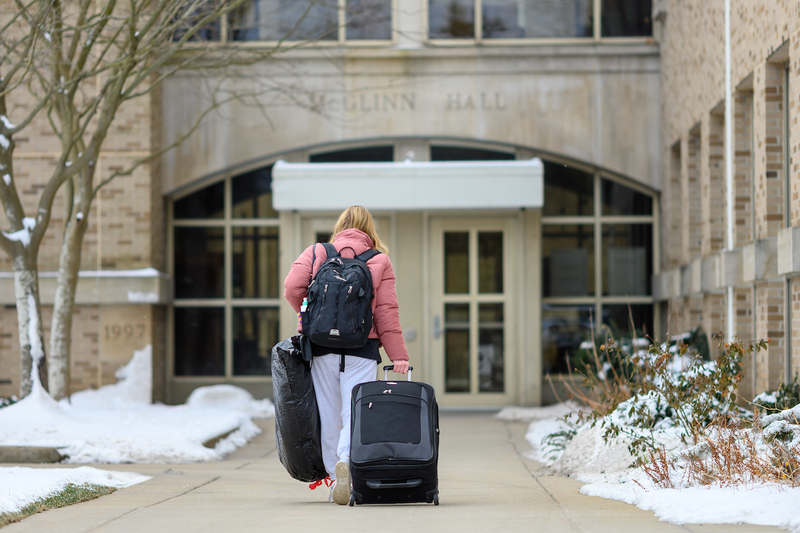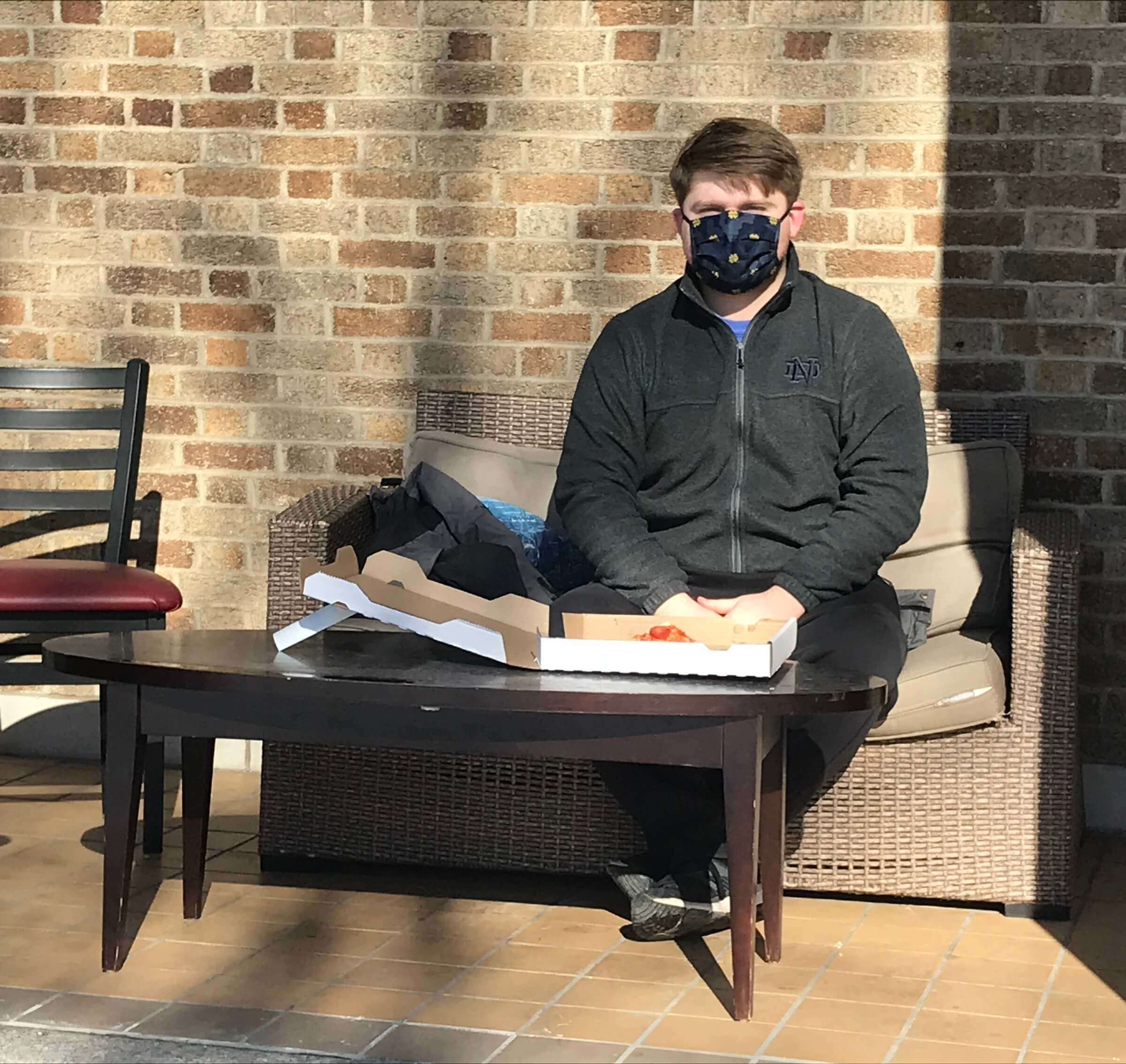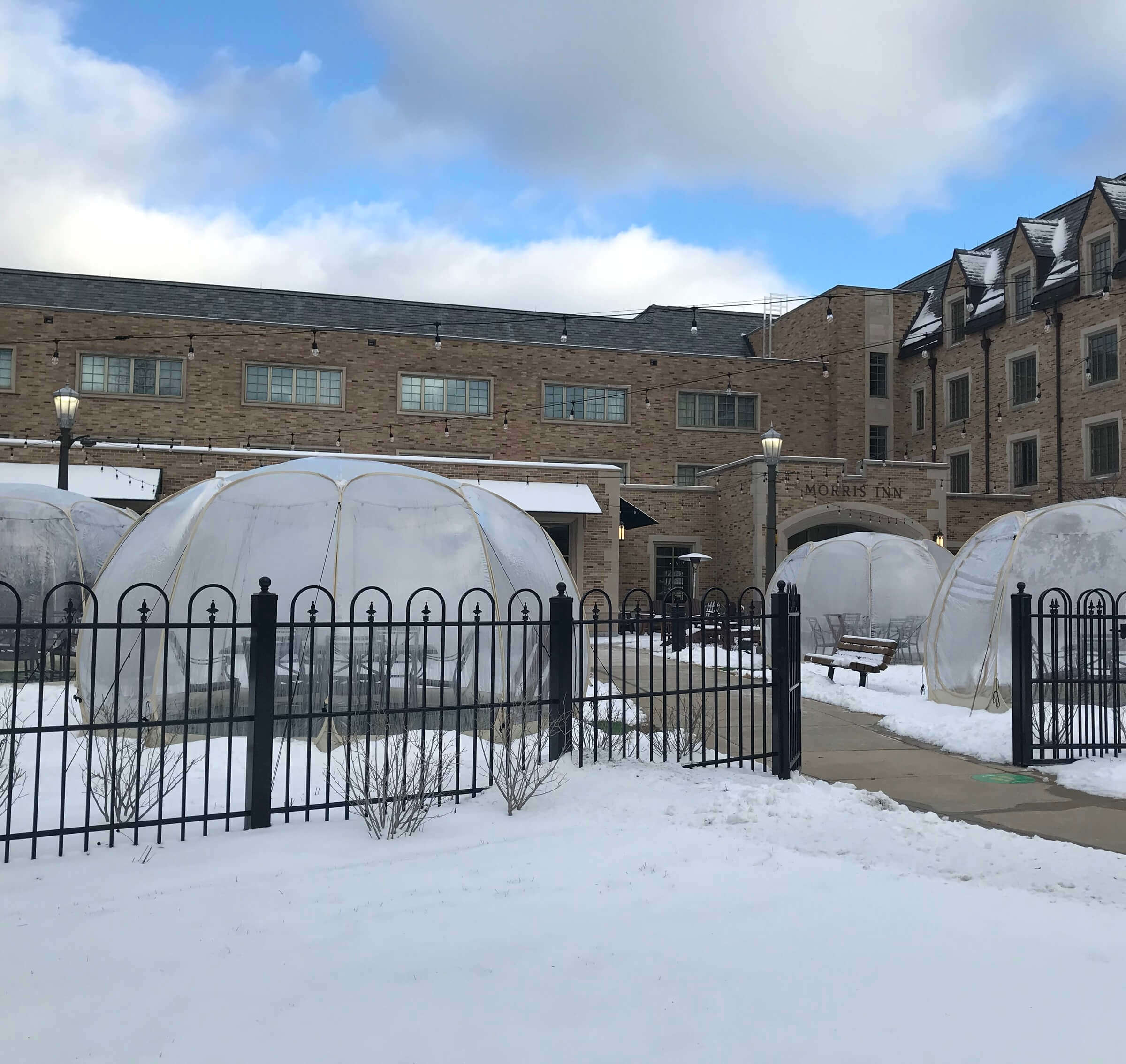 Student Anabel Konesco returns to McGlinn Hall for the spring semester. Photo by Matt Cashore ’94
Student Anabel Konesco returns to McGlinn Hall for the spring semester. Photo by Matt Cashore ’94
All the usual return-to-campus scenes are visible: students wheeling suitcases along sidewalks, unloading SUVs and exchanging greetings with dormmates — albeit while wearing face masks and staying at least six feet apart.
After an extra-long winter break, the snow-covered Notre Dame campus is returning to life.
With the coronavirus still spreading, Notre Dame’s spring semester is expected to be much like fall — with strict rules requiring masks, daily online health checks, and mandates to avoid parties and other gatherings that could increase virus spread. Classes begin Wednesday, February 3, amid a pandemic that so far has killed more than 441,000 Americans.
On January 28, five masked students tossed a Frisbee around on snowy South Quad. Junior Ella Crowley was walking back to her room in Walsh Hall, having driven to campus that morning from her home in suburban Chicago. She immediately went to the Joyce Center for COVID-19 testing and already had received her results: negative.
“I hope by next fall things will be back to normal,” said the masked Crowley, who had hoped to study abroad in Europe this semester. All study abroad programs remain cancelled because of the coronavirus.
In sunny, 25-degree weather on January 29, senior Mike Dugan sat on the front porch of the Knights of Columbus Council Hall, eating carryout pizza. He had just completed COVID pre-matriculation testing, and was waiting for his residence hall access card to be reactivated. (Students are required to complete testing before gaining access to their residence hall rooms to await test results.)
“February is not going to be fun,” said Dugan, a Dillon Hall resident who spent winter break home in New Jersey. With the winter weather, students will stay indoors or in outdoor heated tents, and the campus might experience a spike in cases, he said.
This wasn’t how Dugan envisioned his senior year. But still, in person on campus is what he wanted. “I’m really happy to be here,” he said. “We have to do what we need to do to stay safe.”

For spring semester, Notre Dame is increasing COVID-19 testing requirements for students. All undergraduates will be required to undergo testing once a week, and about 25 percent of the student body will be tested twice a week. Employees, graduate students and postdoctoral researchers who regularly work on campus will be tested once every two weeks.
“We’ll have more regular surveillance testing for everyone,” Provost Marie Lynn Miranda said in a January interview. “I think that’s going to help us a lot.”
The goal of surveillance testing is to identify asymptomatic and pre-symptomatic people before they spread the virus.
The campus HERE dashboard of COVID-19 test results resumed January 18. As of Monday February 1, the dashboard reported a total of 75 cases: 32 undergraduates, 11 graduate students and 32 employees.
To assure compliance with COVID-19 safety measures, the University added a Campus Compact for the Spring Semester for undergraduate and professional students — an addendum to regular rules governing student life and conduct. Students who violate the regulations face strict penalties, including possible dismissal.
Immediately upon return to campus, undergraduates and professional students are required to complete a pre-matriculation COVID-19 testing at the Campus Testing Center in the Joyce Center. Students returning to residence halls have been assigned staggered times so roommates don’t move in simultaneously and no more than 20 percent of residents in a given hall return on the same day.
Because most doctoral and master’s students remained in town for break and participated in weekly surveillance testing, pre-matriculation testing is encouraged but not required for them.
Returning students are expected to remain in their residence hall rooms or off-campus residences until test results are provided (usually within 24 hours), relying on carryout or delivery of meals. Students who test positive enter the University’s isolation protocols, and other students deemed close contacts will be required to quarantine.
As in the fall, the University has rooms reserved both on and off campus for isolating and quarantining students. The equivalent of 12 full-time employees are assigned to handle contact tracing.
Like in the fall, most Notre Dame classes this semester are planned to be provided in person, with masks required and classroom spaces spread out to provide for social distancing. Professors simultaneously provide their classes online for students who are in COVID isolation or quarantine.
Student meals are being served carryout style, with South Dining Hall allowing indoor dining at 15 percent capacity and North Dining Hall at 20 percent capacity. Most students will dine in tents, other designated campus spaces or their dorm rooms.
Because of the pandemic, Notre Dame scheduled an extra-long winter break — from November 21 until February 2. The intent was to keep students away from campus during the darkest and coldest months of the year, when experts predicted the virus might reach peak spread.
Notre Dame was mostly quiet and vacant during the more than two-month winter break. It was so hushed that a small herd of deer at times ventured onto the main part of campus.
To bridge the gap between the fall and spring semesters, Notre Dame offered an experimental Winter Session in January. Faculty created and taught more than 125 courses that met online, plus the University offered ways for students to participate in virtual internships, research experiences and service learning during that month.
Students responded enthusiastically, with nearly 4,000 signing up to take at least one course.
Winter session was “meant to give the students an opportunity to explore some things that they might not otherwise ever spend any time on,” Miranda said, “and maybe shift the way that they think about their course selection going forward.”
Spring semester rules are strict regarding students who don’t appear for testing or who violate campus COVID-19 safety protocols.
Any student who fails to appear for surveillance testing will be placed on probation after the first offense and be issued a formal warning. A student who misses testing a second time will be placed on COVID probation and required to meet with a representative of the campus Office of Community Standards. And a student on COVID probation who fails to report for testing faces dismissal from the University.
As in the fall, informal social gatherings on or off-campus may not exceed 10 people. Students who violate any part of the compact, such as not wearing masks or disobeying other guidelines, will receive a message detailing the offense and a recommended disciplinary outcome.
Notre Dame is applying to the Indiana Department of Health to become a COVID-19 vaccination administration location. If the University is approved to administer vaccines, it will follow guidelines from Indiana’s COVID-19 Vaccine Allocation Plan to determine who is eligible to receive the vaccine and how soon.
During the fall, students spent much of their time outdoors, eating meals on the quads, and studying and socializing on the Library Lawn. Facing colder weather for the next couple months, the University is erecting additional tents on campus for student use.
The University is expanding its TutorND program, created last fall, which offers virtual tutoring and study hall help for children of Notre Dame faculty, staff and graduate students. Some K-12 students have had to attend school virtually because of the pandemic. Most of the tutors, nearly 40 of them, are Notre Dame undergraduates.
Rohr’s restaurant in the Morris Inn has reopened, with limited seating. Several enclosed plastic igloo pods have been placed on the outdoor patio. Legends restaurant has reopened for takeout and delivery only, with orders placed through the Grubhub app.

Some students and faculty members in the fall said the lack of a traditional mid-semester break week made college more challenging. Although there will be no spring break week (because travel could cause a spike in the virus cases) the spring calendar includes three mid-week student break days: March 2, April 2 and April 21. Faculty members have been asked to not schedule exams on the day after those mini-breaks.
Some international students who were unable to return to campus for fall will be back this semester. As in the fall, there will be few campus visitors, with public lectures and conferences presented online.
Varsity sports teams will continue to compete, although several basketball games have been canceled because of COVID-19 positive test results from players on opposing teams. Attendance at men’s and women’s varsity basketball games and Irish hockey matches is limited to guests of student-athletes and coaches of the competing teams. Notre Dame is scheduled to host the 2021 Big Ten Hockey Tournament March 18-20 at Compton Family Ice Arena.
University leaders plan to apply lessons learned during the fall semester to tweak the campus COVID-19 plan as the spring semester progresses.
From August 4 through December 16, the University recorded 1,871 COVID-19 cases: 1,438 among undergraduates, 159 among graduate students and 270 among employees. (Ninety-nine employee cases — 37 percent of the total fall cases among employees — occurred in late November and December, after students had departed campus.)
Most students were absent from campus and the community during what has so far been the height of the pandemic in the South Bend area, late November and December.
St. Joseph County, which includes South Bend and Mishawaka, reached a COVID-19 peak on November 23 with 4,041 active cases. During December, there were 108 COVID-related deaths in St. Joseph County, making it the deadliest month of the pandemic thus far locally.
In recent weeks, there have been promising signs across the Midwest. Indiana on January 26 reported fewer new coronavirus cases and the lowest number of related hospitalizations since early November.
Margaret Fosmoe is an associate editor of this magazine.